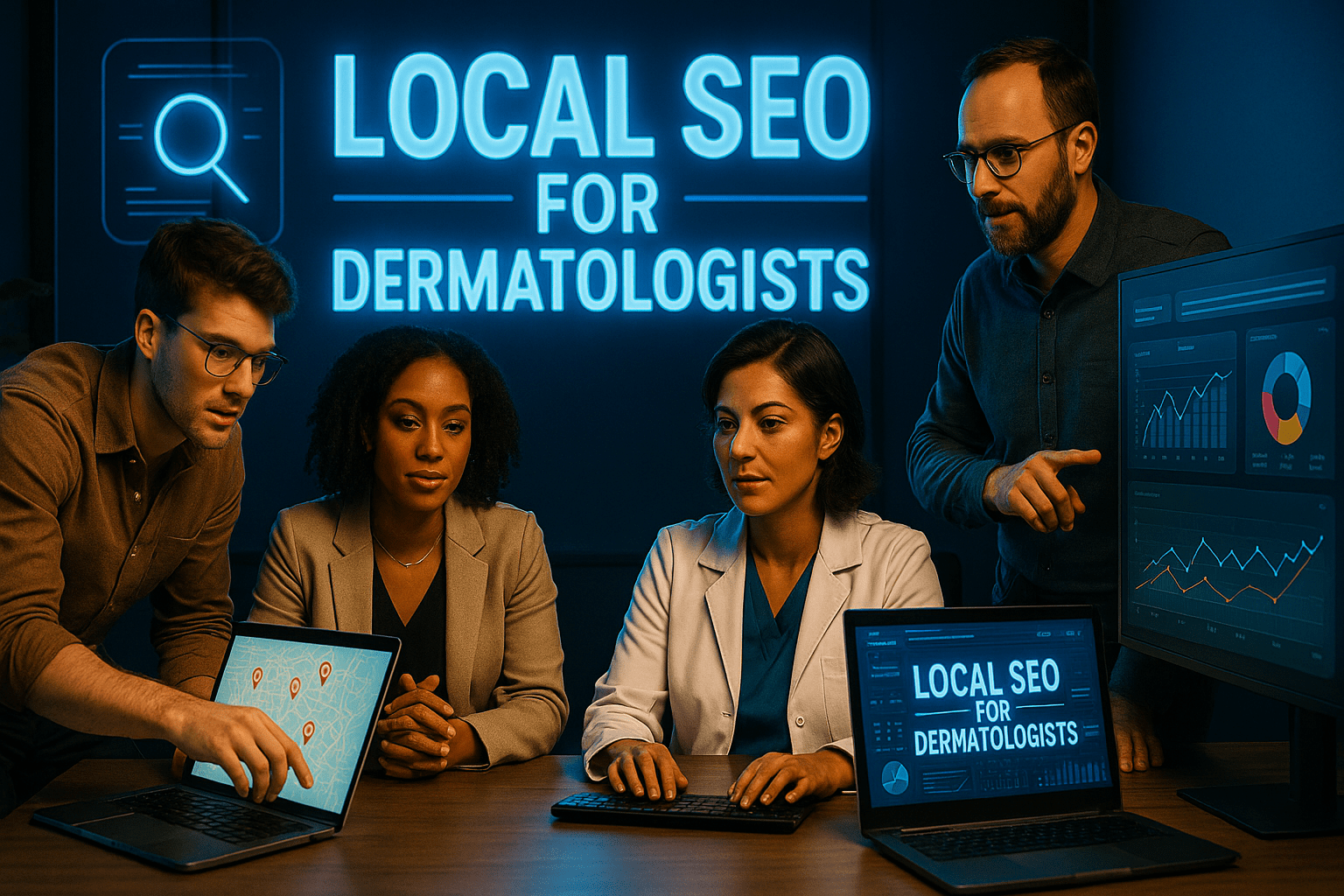Local SEO for Dermatologists: Attract More Patients in Your Service Area
by Design Delulu Editorial · October 6, 2025

Your expertise deserves to be found. When potential patients search for dermatology services in your area, your practice should appear first—not your competitors.
Local SEO has become the deciding factor between thriving dermatology practices and those struggling to fill their appointment calendars. With 76% of people who search for something nearby visiting a business within 24 hours, and 28% of those searches resulting in a purchase, your visibility in local search results directly impacts your bottom line. Yet most dermatologists are either invisible in local search or losing patients to competitors who've mastered the fundamentals of Google Business Profile optimization, citation management, and strategic review generation.
The dermatology market is uniquely competitive. Patients research providers carefully, comparing credentials, reading reviews, and evaluating proximity before booking consultations. They're searching for specific treatments—acne solutions, cosmetic procedures, skin cancer screenings—and they expect to find local experts immediately. If your practice doesn't appear in the local pack or your Google Business Profile looks neglected, you're hemorrhaging qualified leads to practices that may not even match your level of expertise.

Why Dermatologists Need Strategic Local SEO
Dermatology practices face distinct local search challenges that require specialized solutions. Unlike retail businesses with walk-in traffic, dermatology services demand trust-building before the first appointment. Patients evaluate your credentials, review your before-and-after results, scrutinize patient testimonials, and compare your services across multiple touchpoints before they ever call your office.
Your competitors are increasingly sophisticated. Multi-location dermatology chains invest heavily in local SEO infrastructure—optimized location pages, aggressive citation building, systematic review generation, and Google Business Profile management. Independent practices and smaller groups need equally strategic approaches to compete effectively. The playing field isn't level, but it can be navigated with the right systems in place.
Local intent drives dermatology searches. Patients aren't just looking for information; they're ready to book appointments. Search queries like "dermatologist near me," "acne treatment [city name]," or "cosmetic dermatology [neighborhood]" signal high purchase intent. When your practice captures these searches in the local pack—the map results that appear at the top of Google—you intercept patients at the exact moment they're deciding where to schedule their consultation.
The Core Components of Dermatology Local SEO
Effective local SEO for dermatologists rests on four foundational pillars: Google Business Profile optimization, citation consistency, location page architecture, and reputation management. Each component reinforces the others, creating a compound effect that elevates your visibility across local search results.
Google Business Profile optimization serves as your primary local search asset. Your profile must be claimed, verified, and meticulously maintained with accurate hours, services, contact information, and high-quality images. Regular posts highlighting seasonal treatments, new services, or patient success stories signal active management to Google's algorithm. Categories must be precise—selecting the right primary and secondary categories determines which searches trigger your profile. Strategic attribute selection helps patients understand your specializations at a glance.
NAP consistency and citation management establish your practice's credibility across the web. NAP—Name, Address, Phone number—must be identical across every directory, healthcare listing site, and online platform where your practice appears. Inconsistencies confuse search engines and dilute your local ranking signals. A comprehensive citation audit identifies discrepancies across platforms like Healthgrades, Vitals, ZocDoc, WebMD, and industry-specific directories. Systematic cleanup and ongoing monitoring prevent future drift.
Location pages provide the content foundation for multi-location practices or single-location providers targeting multiple service areas. Each page must offer genuine value—unique content addressing local patient needs, service-specific information relevant to that location's demographics, embedded maps, location-specific testimonials, and clear calls-to-action. Template-based approaches fail; successful location pages balance scalability with meaningful differentiation.
Review strategy and management directly influence both rankings and conversion rates. Reviews serve as ranking signals for local pack placement while simultaneously functioning as social proof for prospective patients. A systematic approach to review generation—automated requests timed to positive patient experiences, multi-platform strategy spanning Google, Facebook, and healthcare-specific sites, professional response protocols for both positive and negative feedback—transforms your reputation into a competitive advantage.

Implementation Framework: From Strategy to Results
Local SEO implementation follows a structured four-phase framework designed to minimize waste and maximize impact. This approach prioritizes high-leverage activities, establishes measurement systems early, and creates compounding improvements through systematic iteration.
Phase 1: Discovery & Goals. We begin by mapping your current local search footprint, identifying visibility gaps, and establishing clear success metrics tied to patient acquisition. This phase includes competitive analysis within your service area, keyword research focused on treatment-specific local intent, technical audit of existing location pages and citations, and goal-setting aligned with practice growth objectives. The output is a prioritized roadmap with resource requirements and timeline estimates.
Phase 2: Blueprint. Strategic planning transforms insights into actionable architecture. We design your Google Business Profile optimization strategy, structure location page templates with content frameworks, develop your citation build-out plan across 50-100 relevant platforms, create your review generation and management system, and establish dashboard infrastructure for ongoing measurement. Every decision links directly to measurable patient acquisition outcomes.
Phase 3: Build & Launch. Implementation begins with highest-impact activities. Google Business Profile receives immediate attention—complete optimization, initial post schedule, image library development, and Q&A seeding. Citation building launches systematically across prioritized platforms. Location pages deploy with tracking in place. Review generation systems activate with staff training and patient communication templates. Quality assurance ensures technical excellence before launch.
Phase 4: Optimize. Post-launch iteration drives continuous improvement. Weekly performance reviews identify momentum and obstacles. Monthly deep-dives analyze ranking movement, traffic patterns, and conversion metrics. Quarterly strategic resets reallocate resources based on what's working. This phase never ends—local SEO requires ongoing attention to maintain and extend competitive advantages.
Key Deliverables
- GBP Playbook: Comprehensive optimization guide with posting calendar, image specifications, and maintenance protocols
- Location Page Templates: Scalable content frameworks balancing local relevance with SEO best practices
- Citation Cleanup: Complete audit and correction across 100+ directories and healthcare platforms
- Reviews SOP: Systematic approach to generation, monitoring, and response management
- Dashboard & Reporting: Real-time visibility into rankings, traffic, and patient acquisition metrics
Dermatology-Specific Optimization Tactics
Generic local SEO approaches fail in dermatology because they ignore the industry's unique patient journey and competitive dynamics. Successful strategies account for treatment-specific search behavior, trust requirements, and the dual nature of medical and cosmetic dermatology demand.
Map search intent to patient stages. Awareness-stage patients search for information about conditions and treatments. Consideration-stage patients compare providers and evaluate credentials. Decision-stage patients are ready to book. Your local SEO strategy must address all three stages—educational content for awareness, detailed service pages and provider bios for consideration, and optimized booking flows for decision. Location pages should guide patients through this progression naturally.
Leverage social proof strategically. Before-and-after images, patient testimonials, and success stories build trust faster than credentials alone. Feature these elements prominently in your Google Business Profile posts, location page content, and review responses. Video testimonials perform exceptionally well—short clips of satisfied patients discussing their experience create emotional connection while reinforcing your expertise.
Service-area coverage matters. Even if you operate from a single location, patients throughout your service area need to find you. Strategic content targeting neighborhood names, nearby cities, and local landmarks expands your reach without artificial optimization. Create resources addressing common dermatology concerns in different demographics across your service area—teen acne in specific school districts, anti-aging treatments in affluent neighborhoods, or skin cancer screening in retirement communities.
Measure what matters. Vanity metrics like rankings and traffic mean nothing if they don't drive patient appointments. Establish a single source of truth dashboard tracking new patient consultations by source, treatment-specific appointment requests, phone calls and form submissions from local search, review volume and rating trends, and local pack visibility for priority keywords. Weekly reviews keep your team focused on revenue-generating activities.

Best Practices for Sustainable Local SEO Success
- Prioritize high-impact activities first: Focus on Google Business Profile and top-tier citations before expanding to secondary platforms
- Pair creative with measurement: Every content asset, post, or page should have a clear KPI tied to patient acquisition
- Use templates and systems to scale: Create reusable frameworks for location pages, posts, and review responses that maintain quality while enabling efficiency
- Close the loop regularly: Weekly performance reviews keep tactics aligned with goals; quarterly strategic resets ensure resource allocation matches results
- Build compounding assets: Invest in evergreen content and systematic review generation that continues delivering value long after initial creation
- Stay technically sound: Regular audits of NAP consistency, location page performance, and citation accuracy prevent erosion of gains
Frequently Asked Questions
Let’s level up your Dermatologists business
Need services that actually move the needle for Dermatologists? See our approach, pricing, and timelines—then book a quick call.
Additional Resources
- Schedule Your Strategy Session
Book a complimentary 30-minute consultation to discuss your practice's local search visibility, competitive landscape, and custom local SEO roadmap tailored to your patient acquisition goals.
- View Our Local SEO Portfolio
Explore case studies and results from dermatology practices we've helped dominate local search rankings and increase patient acquisition through strategic local SEO implementation.
- Free Local SEO Tools
Access our suite of free tools including local rank trackers, citation audit reports, Google Business Profile graders, and review monitoring resources designed specifically for healthcare practices.
Related Reading

Dominate local search for immigration law with proven GBP optimization, citation strategies, and conversion tactics. Get more qualified leads starting today.

Master local SEO for physical therapy with proven strategies for Google Business Profile optimization, citation building, and location pages that drive patient appointments.
